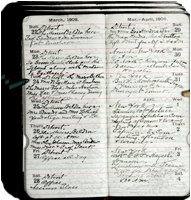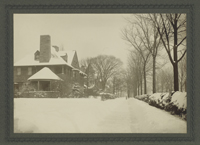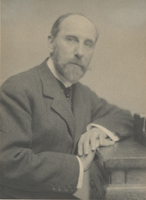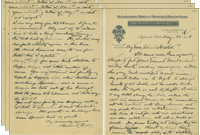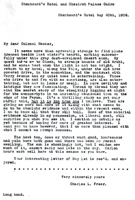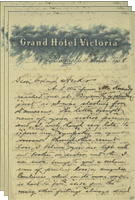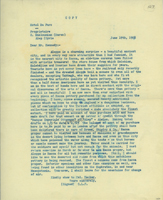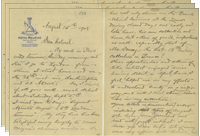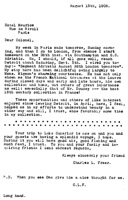Freer's Third Tour: 1908
"An Eager Student on a Quest to the Holy Land"
Freer's stated aim on his 1908 trip to "the Holy Land" was to gain a greater understanding of works in his Near Eastern ceramics collection. With this in mind, he visited Cairo, Aleppo, Beirut, Jerusalem, and Istanbul, and he purchased forty-six ceramic objects from local dealers.
"My quest to the "Holy Land"? -- "Racca pottery," he wrote to Frank Hecker, his former business partner. "I have invested pretty heavily in this line of "fayence" and I consider it necessary to learn what I can."
In 1902 Freer acquired his first pieces of Raqqa ware, a type of ceramic named for the site in north-central Syria where it had been excavated. (Some of the wares that Freer identified as Raqqa are now understood to have been produced at other sites.) These turquoise- and green-glazed vessels with gritty white bodies and thick alkaline glazes appealed to Freer because of their chromatic correspondences with his extensive holdings of East Asian ceramics and American tonalist paintings.
Over the next fifteen years Freer amassed a significant collection of Syrian and Persian Iranian ceramics, with many purchases made from the Paris-based dealers Dikran Kelekian and Siegfried Bing. Kelekian had started selling antique Islamic ceramics in the 1880s and 1890s and was one of the earliest purveyors of Raqqa. In 1909 Kelekian published The Potteries of Persia, in which he described the wares as "beautiful in color and heavily encrusted with iridescence." He noted that "discriminating collectors . . . have grown to love it with a deep and abiding affection quite within the scope of their own emotional experiences."
Freer also purchased a number of Near Eastern ceramics from Siegfried Bing, who supplied him with Japanese wares in the late 1890s. Bing played a key role in introducing Japanese art to audiences in Europe and beyond. As the market in Japanese art began to decline after the turn of the twentieth century, Bing sold textiles and ceramics from the Islamic world after excavations in the 1890s made new goods available to European art and antiques dealers.
Little scholarship on Raqqa and other types of Near Eastern pottery existed during Freer's'time. Based on the highly abraded, iridescent surfaces of the pottery, many dealers and collectors thought the wares were much older than they are now known to be. Freer was aware of the limits of available knowledge. He wrote to Hecker from Syria, "I have already learned how inaccurate much of that which has been hitherto said about the potteries of Damascus and the vast field north and east. This information alone is worth more to my personal collection than I had dared dream." Accurate information on dating and kiln sites for Raqqa and other medieval Near Eastern ceramics was not widely available until after World War II.
Itinerary
- Detroit
- New York City
- Naples
- Capri
- Naples
- Port Said [May 14, 1908 - Mediterranean terminus of Suez Canal]
- Cairo
- Alexandria
- Jerusalem
- Beirut
- Damascus
- Baalbek
- Aleppo
- Rhodes
- Smyrna [then through the Dardanelles to ...]
- Constantinople
- Athens
- Corinth
- Patras
- Olympia
- Corfu
- Trieste
- Vienna
- Budapest [boards the Orient Express to ...]
- Paris
- New York City [August 26]
- Detroit
Detroit
After spending much of the winter at home in Detroit, Freer departed in the spring for a trip to West Asia. "My quest to the "Holy Land"? -- "Racca pottery," he explained to Frank Hecker. He embarked from Boston, where he took the opportunity to meet with the dealer Matsuki Bunkyo and Kakuzō, a scholar of Japanese art who was a key advisor to the collector Isabella Stewart Gardner and the author of The Book of Tea.
Cairo
In Cairo, Freer met with Ali Arabi, the dealer from whom he had purchased the ancient biblical manuscripts the year before. Learning more about the origins of these manuscripts was a major motivation for the trip to Egypt. He also confessed to Frank Hecker that he had come to enjoy bargaining with local dealers, and he made a number of acquisitions, including bronze figures, carved limestone reliefs, and amulets made of faience, metal, stone, and glass.
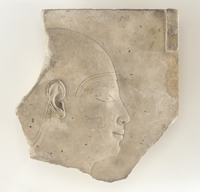
Fragment: a woman's head in relief
Egypt, Dynasty 26 (664-525 B.C.E.).Limestone; 14.9 x 14.1 x 2.1 cm
Aleppo
Freer spent the first few days of June in Jerusalem, visiting the major religious sites in the old city. From there he travelled to Beirut and then to Syria, where he visited Damascus, Baalbek, and Aleppo, which he found to be "a charming surprise---a beautiful ancient city." Part of its appeal was its proximity to Raqqa, the city where so many of Freer's ceramics were believed to have been produced. In Aleppo, which he described as "the store house" from which his Western-based dealers had "drawn their supplies," Freer purchased several pieces of pottery from street vendors.
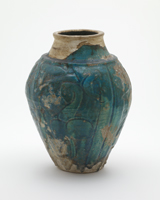
Jar
Purchased from a street vendor in Aleppo. Syrian, 12th-13th century. Stone-paste painted under glaze; 31.9 x 24.4 cm; F1908.113
Paris
Freer concluded his trip to West Asia by way of Europe. He departed from Constantinople on July 5, 1908, and stopped at a number of cities in Greece. By August 1 he was in Vienna, boarding the Orient Express to Paris. On September 6, he returned home to Ferry Avenue in Detroit. Between 1909 and 1911, Freer would make two more tours of Asia. By 1912, his health was seriously failing, and his days as a globetrotting connoisseur came to an end. The last years of his life, spent largely in New York City, were spent culling and organizing his collections and planning their display at the museum in Washington. Freer died in 1919. The Freer Gallery of Art, the first art museum of the Smithsonian Institution, opened to the public some three years later, in 1923.
